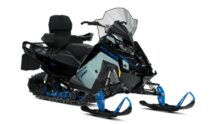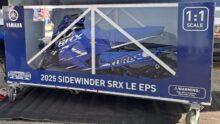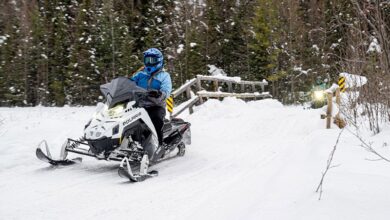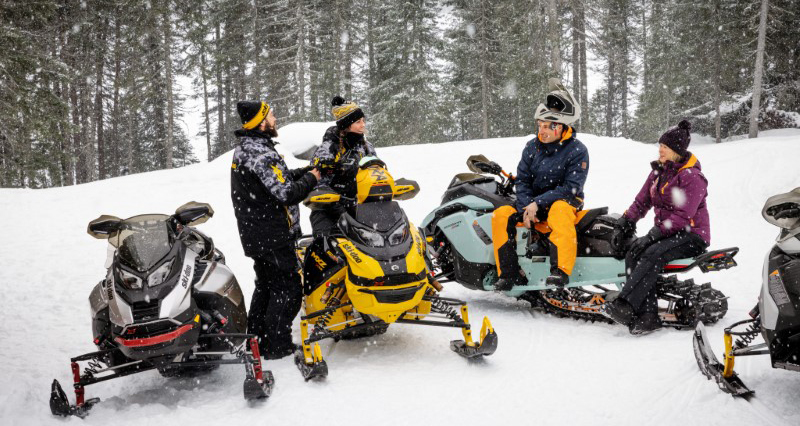Bad winter causes snowmobile sales to trend downward
After a winter of record warmth and low precipitation across the vast majority of snow-starved North America last season, virtually all observers expected new snowmobile sales to trend downward. Really, the only question was how far south they would slide.
In the U.S., the numbers were surprisingly decent. In Canada? They are rather painful to look at. The numbers in European countries also slid slightly, despite decent snow on that side of the Atlantic Ocean. Other parts of the world picked up some sales.
All totaled, snowmobile sales across the planet for the 2024 selling season dipped 9.7 percent to 112,650 units, according to numbers released recently by the International Snowmobile Manufacturers Association (ISMA) at the annual International Snowmobile Congress. The event was held this year in Green Bay, Wisconsin.
The figures reported by ISMA include sales and delivery of new, model year 2024 snowmobiles plus “non-current” new snowmobiles from recent model years retailed during the 2024 sale season. That season went from May 1, 2023, to April 30, 2024. The figures do not include any spring orders of 2025 snowmobiles.
Looking forward, dealer inventories of unsold new snowmobiles are high, and spring pre-orders this year were sluggish. Therefore, some manufacturers have already announced they are significantly cutting the total number of 2025 units they will build.
Snowmobile sales dip in U.S.
Winter got off to a late start across all of the U.S. Snowbelt in the winter of 2023−24. Some parts of the Mountain West eventually received decent snow. But from the Dakotas through Michigan, the Upper Midwest was virtually skunked of ridable snow all winter. Plus, most parts of the Northeast suffered their third subpar winter in a row. In fact, historians are struggling to find a winter that compares in terms of warmth and dryness. Given all of that background, the U.S. sales figures were surprisingly palatable.
Total U.S. new snowmobile sales were 51,987 units. That represents a 2.97 percent decrease over the 53,553 tallied during the 2023 selling season. For context, new snowmobile sales in the U.S. over the past 15 years have averaged 52,963 per year.
“While the U.S. numbers were down, we could almost completely attribute it to lack of snow,” explained longtime ISMA President Ed Klim, who is retiring and handing the reigns of the organization over to Jaret Smith. “There’s not much you can do when it doesn’t snow.”
In the U.S., the Midwest accounted for 42 percent of total sales, while the West contributed 38 percent and the Northeast notched 20 percent, ISMA reported. Snowmobile registrations sat at a solid 1,214,253 in the U.S., which represents a four percent decrease. But considering all of the anecdotal reports of folks not even registering their sleds last year due to winter’s late arrival, Klim says the numbers are decent.
“Overall, that’s not a bad decline considering how poor the snow conditions were,” Klim says. “I look at this as an optimistic outlook. It’s still pretty upbeat as an industry. People want to go snowmobiling, but it’s got to snow! So, start doing your snow dance now.”

With the horrible (by snowmobilers’ standpoint) winter that was experienced, most knowledgeable industry observers (dealers, aftermarket vendors, investor researchers) were expecting far more dire numbers. Those sort of figures, though, were reserved for north of the international border.
Snowmobile sales up North? Oh Canada!
In Canada, sales of new snowmobiles plummeted to their second-lowest number since 1986. The country reported 38,599 new units sold compared to 48,252 a year earlier. That’s a dramatic 20 percent fall-off and the fewest annual sales reported in Canada since 37,670 new snowmobiles were retailed in model year 2010.
As in the U.S., lack of snowfall was the main factor, particularly in parts of Quebec and Ontario. Those provinces make up the majority of snowmobile sales in the country. Incoming ISMA President Jaret Smith, though, informed us of another factor: a larger impact of higher interest rates due to the differences in ways folks finance homes in Canada vs. the U.S.
Eastern Canada accounted for 44 percent of total sales. Thirty-six percent were attributed to the center of the country and 20 percent to the West.
“I think the Quebecois in some ways were in shock last season, because they pretty much always have snow,” Klim adds. Sled registrations in Canada slipped to 555,517 units compared to 618,872 last year.
International snowmobile sales numbers
Snow and cold air was far more plentiful in Scandinavia last winter than on this side of the Atlantic. But sled sales still declined, thanks to the economies that are struggling more there than they are over here in these challenging times.
Snowmobile sales
New sled sales in Sweden were 8,931 in the 2024 sales season, keeping it as the sport’s third biggest country after the U.S. and Canada. The 2024 numbers represent a four percent decrease compared to 2023. Norway accounted for 4,203 units, which was 17% less than in 2023. A total of 4,141 were sold in Finland, which was a 20 percent drop.
Interestingly, the “Other” category outside of North America showed growth, jumping from 3,419 units in the 2023 sales season to 4,789 in 2024.
Klim and Smith both stated that the manufacturers don’t break down where those sales are coming from. Capturing accurate data is made difficult by the fact that such sales typically go through international distributors, Smith explained. He and Klim namechecked China, Japan, Poland and Moldova as locations of some sales. But the sales are truly scattered across the globe, they say. Overall, the biggest thing missing from the International numbers is the Russian market due to trade embargoes.
“Before they invaded Crimea [in 2014] we were reporting 30,000 units sold in Russia at that point in time,” Klim says. “So, that went from 30,000 to zero. So when you look at the overall international sales, most of the big decline is because the Russian market has disappeared.”
New model highlights
Yamaha
The 2025 SRX features a numbered final edition badge, and the sidewinder LTX Le has a heated seat, 20-inch tunnel bag, and lightweight disc.
Arctic Cat
The 2025 models are built on the CATALYST platform, which is designed to be rider-centric and offers options like the 600 or 858 engine, and the ATACH accessory system. The RIOT model is available with the 600 DSI or 858 engine, and uses Arctic Cat’s belt drive final drive system.
Polaris
The 2025 lineup includes mountain, cross-over, trail, sport utility, and sidetrack sleds, and features new technology and upgrades to enhance the riding experience. For example, the RMK lineup is lighter for more control, and the DYNAMIX suspension technology offers more comfort and control.
Ski-Doo
The 2025 models are designed to deliver dynamic power, precision, and exhilaration, and include new features like the RAS RX front suspension and front end to improve steering precision and reduce chassis roll. The Summit snowmobiles are equipped with the Rotax engine for deep snow navigation and agility.
Ski-Doo also announced two new electric models for 2025, the Ski-Doo Expedition Electric and the Lynx Adventure Electric, which are designed for multi-use applications.
Winter forecast for ’24-’25 snow season
LA NIÑA
The National Weather Service (NWS) favors La Niña to develop between July and September 2024, with an 85% chance of it continuing into the Northern Hemisphere winter. La Niña can cause colder than normal water temperatures in the Equatorial Pacific Ocean, which can lead to colder air in the winter.
TEMPERATURE
Weather.com predicts a warmer and drier winter in the South and a colder winter in the Northern Plains. SnowBrains.com predicts colder than average temperatures in the Pacific Northwest, but warmer temperatures in some areas of the Rocky Mountains.
PRECIPITATION
Weather.com predicts a wetter winter in the Pacific Northwest. While SnowBrains. com predicts higher than normal precipitation in the Pacific Northwest, and potentially good snow conditions in some areas of the Rocky Mountains
The 12-Month Long-Range Weather Report From The 2024 Old Farmer’s Almanac: Winter will be colder than normal, with above-normal precipitation and snowfall. The coldest spells will occur in late December, early January, and late January through mid-February.












I don’t believe the low sales had anything to do with low snow. People were still riding here in Canada in June. I’d say the lack of quality and high prices has a lot more to do with it..